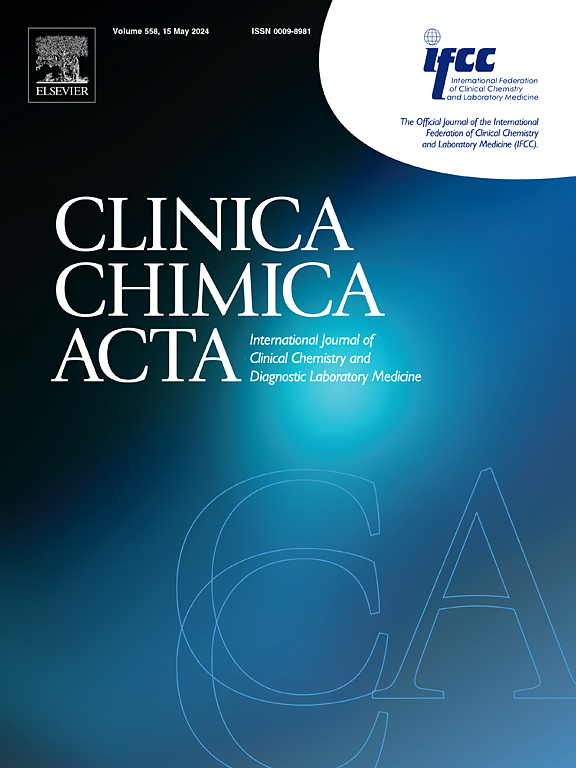Correlation of APOE polymorphism, expression, and plasma levels with cardiac comorbidities among lipodystrophy in HIV-infected patients
IF 3.2
3区 医学
Q2 MEDICAL LABORATORY TECHNOLOGY
引用次数: 0
Abstract
Lipodystrophy in HIV-infected patients (LDHIV) includes morphological and metabolic abnormalities, including lipid and glucose metabolism. ApoE plays a role in the transport and clearance of lipoprotein. In the general population, ApoE 112 (rs429358) and 158 (rs7412) polymorphisms were linked to severe dyslipidemia. Therefore, we investigated ApoE polymorphism using PCR-RFLP in 200 HIV patients (100 with HIV-associated lipodystrophy (HIVLD), 100 without HIVLD), as well as 100 healthy controls. We also assessed ApoE expression using qRT-PCR and measured its level using ELISA. The APOE 4/4, 3/4, and 2/4 genotypes have been associated with a decreased risk of HIV-1 infection. (P = 0.0001, OR = 0.18; P = 0.006, OR = 0.87; P = 0.006, OR = 0.09) when compared between HIV-positive individuals and healthy controls. Conversely, APOE allele 2 was linked to a higher risk of acquiring HIV-1 (P = 0.03, OR = 3.02). APOE allele 2 was linked to a higher likelihood of HIVLD severity when compared between patients with and without HIVLD (P = 0.05, OR = 2.82). When comparing patients with HIVLD to healthy controls, the APOE 4/4 and 2/4 genotypes as well as allele 4 were linked with the reduced risk of LDHIV (P = 0.0006, OR = 0.21; P = 0.01, OR = 0.18; P = 0.0002, OR = 0.40). When compared to patients without HIVLD from healthy controls, the ApoE 4/4 genotype, 2 and 4 alleles, were linked to a reduced risk of developing HIVLD (P = 0.0009, OR = 0.14; P = 0.0001, OR = 0.17; P = 0.00001, OR = 0.39). When comparing impaired to normal cholesterol levels in patients without HIVLD, the ApoE 3/4 genotype was linked with the increased risk of impaired cholesterol levels (P = 0.02, OR = 3.37). When comparing impaired and normal glucose levels in patients without HIVLD, the ApoE 4/4 genotype was associated to an elevated risk of impaired glucose levels (P = 0.03, OR = 8.27). In multivariate analysis, independent impaired cholesterol, LDL, and glucose levels were associated with a higher risk of lipodystrophy severity (P = 0.04, OR = 2.33; P = 0.001, OR = 4.05; P = 0.05, OR = 2.63). ApoE expression was up-regulated in LDHIV with a fold change value of 4.02 compared to those without HIVLD. ApoE protein level was found to be higher in patients of the HIVLD group (3.01 mg/dL) compared to those without HIVLD group (2.83 mg/dL). In conclusion, individuals with ApoE allele 2 were at higher risk for HIV-1 acquisition and severity of HIVLD, whereas those with ApoE allele 4 were at reduced HIVLD severity and development risk. It’s possible that ApoE’s increased level and its overexpression are related to the ApoE allele 2 in HIVLD patients. The development of LDHIV may be facilitated by the APOE 3/4 and 4/4 genotypes as well as abnormal glucose and cholesterol levels.
APOE多态性、表达和血浆水平与艾滋病病毒感染者脂肪营养不良的心脏并发症的相关性。
艾滋病病毒感染者(LDHIV)的脂肪营养不良包括形态和代谢异常,包括脂质和葡萄糖代谢异常。载脂蛋白E在脂蛋白的转运和清除中发挥作用。在普通人群中,载脂蛋白E 112(rs429358)和158(rs7412)多态性与严重的血脂异常有关。因此,我们采用 PCR-RFLP 技术调查了 200 名艾滋病患者(其中 100 人患有艾滋病相关性脂肪变性症(HIVLD),100 人无 HIVLD)和 100 名健康对照者的载脂蛋白酶多态性。我们还使用 qRT-PCR 评估了载脂蛋白E的表达,并使用 ELISA 测定了载脂蛋白E的水平。APOE 4/4、3/4 和 2/4 基因型与 HIV-1 感染风险降低有关。(与 HIV 阳性个体和健康对照组相比,APOE 4/4、3/4 和 2/4 基因型与 HIV-1 感染风险的降低有关(P=0.0001,OR=0.18;P=0.006,OR=0.87;P=0.006,OR=0.09)。相反,APOE 等位基因 2 与感染 HIV-1 的较高风险有关(P=0.03,OR=3.02)。当将 HIVLD 患者与非 HIVLD 患者进行比较时,APOE 等位基因 2 与 HIVLD 严重程度较高的可能性有关(P=0.05,OR=2.82)。当将HIVLD患者与健康对照组进行比较时,APOE 4/4和2/4基因型以及等位基因4与LDHIV风险降低有关(P=0.0006,OR=0.21;P=0.01,OR=0.18;P=0.0002,OR=0.40)。与健康对照组中无 HIVLD 的患者相比,APOE 4/4 基因型、2 等位基因和 4 等位基因与 HIVLD 的发病风险降低有关(P=0.0009,OR=0.14;P=0.0001,OR=0.17;P=0.00001,OR=0.39)。在比较无 HIVLD 患者的胆固醇水平受损与正常时,APOE 3/4 基因型与胆固醇水平受损的风险增加有关(P=0.02,OR=3.37)。在比较无 HIVLD 患者的血糖水平受损和正常时,APOE 4/4 基因型与血糖水平受损的风险升高有关(P=0.03,OR=8.27)。在多变量分析中,独立的胆固醇、低密度脂蛋白和血糖水平受损与脂肪营养不良严重程度风险升高有关(P=0.04,OR=2.33;P=0.001,OR=4.05;P=0.05,OR=2.63)。LDHIV 中 APOE 表达上调,与未患 HIVLD 者相比,其折叠变化值为 4.02。与无 HIVLD 组(2.83 mg/dL)相比,HIVLD 组患者的 APOE 蛋白水平更高(3.01 mg/dL)。总之,具有 APOE 等位基因 2 的人感染 HIV-1 的风险较高,HIVLD 的严重程度也较高,而具有 APOE 等位基因 4 的人 HIVLD 的严重程度和发展风险较低。APOE水平的升高和过度表达可能与HIVLD患者中的APOE等位基因2有关。APOE ¾ 和 4/4 基因型以及异常的葡萄糖和胆固醇水平可能会促进 LDHIV 的发展。
本文章由计算机程序翻译,如有差异,请以英文原文为准。
求助全文
约1分钟内获得全文
求助全文
来源期刊

Clinica Chimica Acta
医学-医学实验技术
CiteScore
10.10
自引率
2.00%
发文量
1268
审稿时长
23 days
期刊介绍:
The Official Journal of the International Federation of Clinical Chemistry and Laboratory Medicine (IFCC)
Clinica Chimica Acta is a high-quality journal which publishes original Research Communications in the field of clinical chemistry and laboratory medicine, defined as the diagnostic application of chemistry, biochemistry, immunochemistry, biochemical aspects of hematology, toxicology, and molecular biology to the study of human disease in body fluids and cells.
The objective of the journal is to publish novel information leading to a better understanding of biological mechanisms of human diseases, their prevention, diagnosis, and patient management. Reports of an applied clinical character are also welcome. Papers concerned with normal metabolic processes or with constituents of normal cells or body fluids, such as reports of experimental or clinical studies in animals, are only considered when they are clearly and directly relevant to human disease. Evaluation of commercial products have a low priority for publication, unless they are novel or represent a technological breakthrough. Studies dealing with effects of drugs and natural products and studies dealing with the redox status in various diseases are not within the journal''s scope. Development and evaluation of novel analytical methodologies where applicable to diagnostic clinical chemistry and laboratory medicine, including point-of-care testing, and topics on laboratory management and informatics will also be considered. Studies focused on emerging diagnostic technologies and (big) data analysis procedures including digitalization, mobile Health, and artificial Intelligence applied to Laboratory Medicine are also of interest.
 求助内容:
求助内容: 应助结果提醒方式:
应助结果提醒方式:


